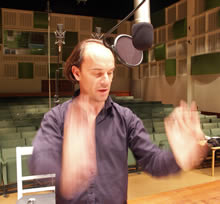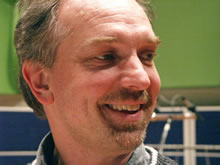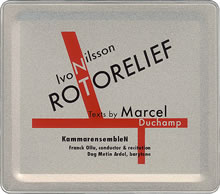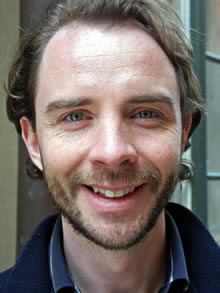|
PRESS INFORMATION As pdf-document in
English
|
|
|
The cd 6x5 cm, 300 dpi (jpg, 280K) Free to download and use |
|
|
|
Ivo Nilsson, composer Photo: SFZ records Free to download and use only with a review of SFZ 1006. |
|
 |
|
Franck Ollu, conductor Photo: SFZ records Free to download and use only with a review of SFZ 1006. |
 |
Dag Metin Ardel, barytone Photo: SFZ records Free to download and use only with a review of SFZ 1006. |
Links
Homepage of Ivo Nilsson |
|
![]()
ROTORELIEF (SFZ records, SFZ 1006,
distribution CDA)
Sounding rotating reliefs
In 1926 the artist Marcel Duchamp, the photographer Man Ray and the director
Marc -Allegret presented a seven-minute film where a number of rotating
optical an verbal discs where shot. The film was called Anémic-cinéma
and the texts on the discs consist of puns of the kind -Duchamp was -attracted
by. The discs were called Rotorelief.
Later Duchamp created several rotating optical Rotoreliefs which were
duplicated in purpose to be used on a gramophone. When the discs rotated,
an optical illusion of geometrical patterns and depth was created.
When the Swedish composer and trombone player Ivo Nilsson saw the Rotoreliefs
in action for the first time his -immediate reaction was: “What would
they sound like?” Inspired by the optical discs he wrote twelve short
movements for chamber ensemble. They are all instrumental and may also
be performed as an orchestral suite. Another 17 movements were inspired
by the film Anémic-Cinéma and are presen-ted in the order
in which they appear in the film. The texts on the verbal discs from Anémic-Cinéma
are either sung or recited.
The puns in the texts by Duchamp are reflected in the musical structure
and material used in the piece. -Rotorelief begins with the sound from
a film projector and the string section, piano and harp initially play
with rotating wooden wheels, in purpose to bring the sound of the projector
into the ensemble. The musicians also play on musical glasses, with chessmen,
drops of water, coins and a pair of scissors. Even the squeaking sounds
from forks and plate is added to the score. These objects (which are mentioned
in the texts or in a way or another are connected to Duchamp) thus become
a kind of acoustical “ready-mades” which were a part of the
aesthetics of Duchamp.
One of the Rotoreliefs is printed on the cd label and by putting the cd
on a finger and rotating it you will be aware of the optical illusion
created by Duchamp. The cd box, made of tin, gives the feeling of holding
a film box.
Rotorelief by Ivo Nilsson and with texts by Marcel Duchamp is composed
1999-2001 and is performed by the KammarensembleN conducted by Franck
Ollu - who on this recording also recites some of the texts (simultanously
conducting!). The vocal parts are sung by Dag Metin Ardel.
Rotorelief was commissioned by the Swedish Concert Institute and the recording
is a collaboration between the KammarensembleN and SFZ records and is
produced with financial support by the Swedish National Council for Cultural
Affairs.
Further information about the production and press pictures: www.sfz.se/1006
The cd is distributed through CDA (Compact Distribution AB), Sweden, +46
8 442 11 20, +46 8 442 11 33 (fax), info@cda.se.
![]()
ROTORELIEF (SFZ records, SFZ 1006,
distribution CDA)
Tonsatta roterande reliefer
1926 presenterade konstnären Marcel Duchamp, fotografen Man Ray och
regissören Marc -Allegret en sju minuter lång film där
man kunde se ett antal snurrande cirkelformade skivor med texter och med
olika optiska mönster. Filmen hette Anémic-cinéma och
skivornas texter bestod av ord-lekar av det slag som -Duchamp var mycket
förtjust i. De här skivorna kallades Rotorelief.
Duchamp gjorde senare ett antal roterande optiska Rotoreliefer som massproducerades
för att placeras på en grammofon. När man betraktade de
roterande skivorna uppstod spiraler och andra former men också en
viss djupverkan.
När tonsättaren och trombonisten Ivo Nilsson för första
gången såg de snurrande skivorna blev hans första tanke:
“Hur låter en Rotorelief?” Inspirerad av de optiska skivorna
skrev Ivo då tolv korta stycken för kammar-ensemble. De är
helt instrumentala och bildar en svit som kan framföras separat.
Han skrev därefter ytterligare 17 delar till lika många Rotoreliefer
varav nio tolkade de textskivor som visades i filmen från 1926.
Texten reciteras eller sjungs.
Duchamps ordlekar avspeglas också i musikens material och struktur
och hela klangbilden är inspirerad av Rotorelieferna. Rotorelief
inleds med ljud från en filmprojektor och stråk-sektionen
spelar till en början med roterande trätrissor för att
kunna ta med projektorljudet in i ensemblen. Här spelas också
på glas och i vatten, med schackpjäser, mynt och saxar. Även
gnisslande ljud från bestick på en tallrik finns inkomponerat.
På så sätt blir de här objekten (som förekommer
i texterna eller på något annat sätt har anknytning till
Duchamp) en slags klingande “ready-mades” av det slag Duchamp
själv uppmärksammades för.
På cd-skivan är en av Duchamps Rotoreliefer tryckt, och sätter
man den på fingret och snurrar kan man uppleva den optiska illusionen.
Cd:n är förpackad i en B/Box i plåt – vilket ger
känslan av att hålla i en filmburk.
Ivo Nilssons Rotorelief, till texter av Marcel Duchamp, är komponerad
1999-2001 och framförs av KammarensembleN under ledning av Franck
Ollu - som på inspelningen också reciterar några av
texterna (samtidigt som han dirigerar!). Dag Metin Ardel står för
de vokala partierna.
Rotorelief är Rikskonserters beställningsverk och cd-utgivningen
är ett samarbete mellan KammarensembleN och SFZ records och är
producerad med stöd från Kulturrådet.
Mer information om produktionen inkl fria pressbilder på www.sfz.se/1006

